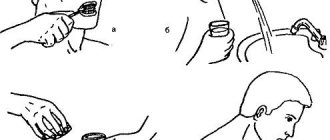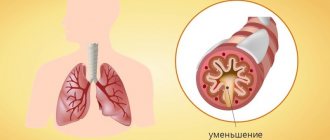Sputum is liquid or viscous mucus, which consists of tracheobronchial secretions, nasal secretions and saliva. If white sputum is produced when you cough, this does not always indicate a serious illness. To determine the cause of coughing up mucus, pay attention to the accompanying symptoms - sore throat, wheezing in the lungs, fever, malaise. If you notice at least two symptoms, consult a doctor. He will prescribe diagnostics - laboratory tests, bronchoscopy, fluorography.
Causes of productive cough
A cough is called productive,
accompanied by the release of mucus. White sputum, as well as other shades, is expectorated. A productive cough occurs when:
- acute upper respiratory tract diseases;
- chronic lung diseases;
- inflammation in the nasopharynx, which is accompanied by accumulation of mucus;
- allergies;
- presence of an addiction: smoking;
- reflux (penetration of stomach contents into the esophagus).
There are many diseases that begin their development with a nonproductive (dry) cough. During therapeutic measures, it becomes productive (white sputum is coughed up).
White sputum when coughing cleanses the respiratory system of pathogenic microbes.
If the pathological condition lasts more than three days, you need to see a doctor.
Is it possible to swallow phlegm in the throat?
The accumulation of mucus in the throat forces the patient to pay attention to it.
There are only two options: expectoration or swallowing. Both processes are physiological. Swallowing is harmless: sputum passes into the stomach and is broken down into components. Enzymes in the gastric juice transform mucus into water, which returns to the body and brings only benefits. Harmful components are digested and excreted naturally.
The feeling of mucus in the throat due to hypersecretion of the glands of the respiratory system is normal. These nerve endings signal stagnation of phlegm. The main thing is the absence of suffocation, which is a dangerous sign of the development of events: swelling of the larynx with a threat to life.
Sputum in the lungs by composition
What does it mean if the discharge has no color (transparent)
If there is clear mucus, this does not mean that you can calm down and not consult a doctor. This type of sputum often occurs without coughing. The causes of the pathological condition lie in lesions of the nasopharynx.
If clear mucus comes out when you cough, in some cases this indicates infectious pathologies. Lack of color is usually characteristic of their chronic course. Colorless sputum is caused by:
- pathologies of the cardiovascular system (discharge is observed in a small volume);
- oncological diseases (accompanied by a strong cough, after which sputum comes out);
- laryngitis (cough lasts for a long period of time, little is secreted);
- allergic reaction (discharge caused by irritation of the internal membranes).
The causes of hyperproduction of mucus during coughing can be various factors. It is possible to establish the exact nature of its origin only with a complete diagnosis.
Other reasons
If sputum accumulates in the throat due to allergies, then you should take antihistamines (Suprastin, Cetirizine, Loratadine, Tavegil). Relief should occur within the first day of using them. If the symptom is caused by reflux and reflux of stomach contents, then treatment is prescribed by a gastroenterologist.
It will be individual for each patient (with the use of enzymes, anti-inflammatory drugs and dopamine receptor blockers).
You will also be interested in:
- How to treat a dry cough in an adult that lasts for a long time without fever
If the symptom is in an adult without fever
White sputum when coughing without fever in adults manifests itself in the following pathological conditions:
- allergy;
- heart failure;
- foreign objects in the air duct;
- inhalation of chemicals;
- nicotine addiction;
- chronic bronchitis in remission;
- neoplasms in the respiratory organs, gastrointestinal tract.
Infectious and non-infectious causes provoke white mucus. In the second case, it is easier to get rid of the pathological condition: you need to give up addictions and adhere to a healthy lifestyle.
Foamy and viscous cough
When passing through the respiratory tract, sputum may become slightly foamy.
Normally, the volume per day should not exceed 10 ml. When it comes out, it is swallowed back. If everything is in order with a person’s health, the discharge has no odor.
Viscous sputum appears with allergies:
- if the pathological condition is severe;
- with frequent contact with a provocateur (allergen): the mucous membrane swells because of this, swelling occurs.
If the discharge is caused by an allergic reaction, there should be no admixtures of pus or blood clots in the mucus.
White or yellowish viscous sputum occurs with bronchial asthma and indicates a prolonged course of the disease. When the pathological condition worsens, the mucus becomes viscous and transparent. Sputum of this nature is called glassy.
If viscous mucopurulent discharge is observed, this indicates the addition of an infectious agent.
If viscous sputum occurs, you need to undergo diagnostics. If its consistency is quite thick, the mucus can clog the airways. This will lead to serious complications.
Principles of treatment of cough with sputum
If a person is suffering from a cough with sputum, it is recommended to provide plenty of fluids; it is possible to use drugs or herbal remedies that have an expectorant, anti-inflammatory, enveloping and bronchodilator effect. There are several groups of medications that are prescribed to relieve the symptoms of wet cough:
- expectorants . They are prescribed for viscous sputum to facilitate the process of its removal from the respiratory tract. A similar effect is achieved through reflex stimulation of the glands located in the bronchial mucosa. When using these drugs, the amount of mucus may increase due to the dilution of sputum;
- mucoregulating agents. They help reduce the secretion of sputum and, like expectorants, allow it to be removed from the body. In case of exacerbation of bronchial asthma, the use of these drugs is contraindicated, therefore, before taking, you should consult with your doctor;
- mucolytic agents. They improve the removal of sputum by stabilizing the release of bronchial secretions. These drugs are usually prescribed for tracheitis, bronchitis, pneumonia and other diseases;
- antihistamines. They are prescribed if the cough is a consequence of allergies. They help alleviate the consequences of the body's reaction to certain irritants. If you are bothered by a sore throat, sputum of unusual color and consistency, cough, fever and other unpleasant symptoms, you should consult a doctor. Such manifestations are a consequence of a number of diseases, so consultation with a specialist is necessary to make a diagnosis and select therapy. This will help avoid complications and start treatment in a timely manner.
What other color can sputum be?
White sputum when coughing can be a response to pathogenic microflora in the respiratory system, a sign of the development of bronchial asthma.
Mucus can have other shades.
Its basis is
water with glycoproteins, fats, antibodies. Depending on the components, the color of the discharge also changes. It can vary from faint yellow to brownish.
Yellow
Yellowish discharge indicates the development of diseases:
- bronchitis;
- pneumonia;
- sinusitis.
A yellow tint usually appears when sputum is mixed with purulent discharge. This is a dangerous pathological condition that requires immediate medical attention. The sooner treatment is started, the better the prognosis. Yellowish sputum is also observed in heavy smokers.
Green
A greenish discharge indicates the following pathologies:
- bronchitis of various pathogenesis;
- lobar pneumonia.
The pathological condition may be accompanied by fever, difficulty breathing, and chest pain.
With blood
Red sputum indicates internal hemorrhage. In this case, clots and streaks of scarlet color are observed in the discharge. If the blood begins to clot, its color becomes rusty.
Sputum with blood is observed when:
- pneumococcal pneumonia;
- malignant neoplasms in the lungs;
- tuberculosis;
- pulmonary embolism.
Internal bleeding poses a serious threat not only to health, but also to life. Therefore, if you experience red sputum when coughing, you should immediately visit the hospital.
Brown
Brown mucus when coughing usually has a non-infectious cause and is associated with destructive processes in the lungs caused by exposure to tobacco smoke or other toxic substances (for example, at work).
It is impossible to establish an accurate diagnosis from sputum alone. You need to undergo diagnostics. Only a specialist in a clinic can do this.
How to treat cough with mucus in an adult
Features of therapy depend on the cause of productive cough. For infectious diseases, complex treatment is carried out using:
- medicines;
- physiotherapy;
- diets.
During periods of exacerbation of respiratory infections, bed rest is necessary. The sick person must be provided with warm drinks.
Drugs
Sputum production indicates a highly productive cough. To speed up the clearance of mucus from the airways, mucolytic and expectorant agents are used:
- Bronkatar is a syrup with carbocisteine, which stimulates the mucociliary system, strengthens the local immunity of the bronchi, trachea and lungs;
- Pertussin - syrup with thyme, ethanol and potassium bromide, which increases cough productivity if sputum is difficult to cough up;
- Lazolvan - tablets with ambroxol, which reduce sore throats, thin and remove mucus;
- Sinupret - herbal tablets with extracts of verbena, gentian and primrose, which eliminate inflammation and stimulate the mucociliary system;
- Prospan - syrup with ivy extract, which facilitates the removal of mucus from the bronchi, walls of the trachea and throat;
- Mucaltin - tablets with marshmallow herb that reduce the elasticity and viscosity of bronchial mucus.
A sore throat is a reason to use lozenges and lozenges with anti-inflammatory and antiseptic additives.
For productive cough the following are indicated:
- Falimint – disinfects the mucous membrane, relieves inflammation;
- Linkas Lor – increases cough productivity, heals the epithelium;
- Anti-Angin – reduces inflammation, eliminates fungal and bacterial flora;
- Agisept - softens the throat, destroys microbial flora;
- Strepsils – prevents the addition of fungal and bacterial infections;
- Septolete – reduces sore throat, disinfects mucous membranes.
To speed up recovery, it is recommended to inhale with a nebulizer or steam inhaler.
In case of elevated temperature and purulent inflammation of the lower respiratory tract, only aerosol inhalers (nebulizers) are allowed.
Preparations for inhalation:
- Ambrohexal - thins tracheobronchial mucus, relieves sore throat;
- Fluimucil antibiotic – destroys bacterial infection, increases cough productivity;
- Rotokan - heals the mucous membrane, softens the throat and accelerates metabolism;
- Tonsilgon N – increases local immunity, relieves inflammation, destroys microbial flora;
- Berotek – eliminates bronchospasms, increases the diameter of the bronchi;
- Interferon – stimulates the body to fight infections;
- Pulmicort – eliminates allergy symptoms, relieves swelling and inflammation.
If the throat is red, gargling should be done 5-7 times a day. To reduce inflammation and heal the mucous membrane, use:
- Furacilin – destroys microbial infection;
- Miramistin – disinfects the oral cavity;
- Chlorophyllipt – kills staphylococcal infection;
- Stopangin - reduces pain, accelerates regeneration and disinfects the mucous membrane;
- Eludril – inhibits the proliferation of bacteria, relieves inflammation.
With complex treatment, the risk of secondary infections is reduced. By strengthening local immunity, the recovery period is reduced by 1.5-2 times.
Folk remedies
If you are bothered by a cough with sputum production, traditional medicine will help. In terms of effectiveness, they are not inferior to symptomatic drugs.
Means for oral administration:
- Coltsfoot. 7-8 g of herb are poured into 350 ml of water. Boil over low heat for 5 minutes, strain through cheesecloth. Drink half a glass 4 times a day.
- Plantain with mint. Mix mint with plantain in a 2:1 ratio. 2 tbsp. l. the raw materials are boiled in 400 ml of water for 4 minutes. If the sputum does not come away, take a decoction of 200 ml up to 5 times a day.
- Milk with soda and honey. 250 ml of milk is heated to 50-55°C. Mix with 15 ml of melted honey and 1/3 tsp. soda Drink before bed for 1 week.
A cough with expectoration of sputum is a reason for warm-moisture inhalation. If you don’t have a special inhaler, use a saucepan and a towel.
To prevent burns, the liquid can only be heated to a temperature of 45-50°C. The duration of the procedure varies from 3 to 15 minutes.
Solutions for steam-moisture inhalations for coughs:
- Mineral water. 300 ml of Essentuki No. 4 or Borjomi is heated on the stove. Add 3-4 drops of fir, rosemary or juniper oil.
- Herbal decoction. Chamomile is mixed with plantain and mint leaves in equal proportions. 15 g are boiled in 300 ml of water for 5 minutes, then cooled to the optimal temperature.
Mouth rinse solutions for productive cough:
- Classic recipe. Dissolve ½ tsp in 250 ml of water. soda and 1 tsp. salt. Heat to 45°C and add 2 drops of iodine.
- With oak bark. 1 tbsp. l. steam 250 ml of boiling water. After 3 hours, filter the infusion.
- With propolis tincture. Add 5 ml of tincture to 250 ml of warm water. If desired, add 2 drops of eucalyptus oil.
To speed up recovery, rinsing is performed daily every 1.5-2 hours.
Additional measures
When you are bothered by a cough with white sputum without fever, heat treatment will help. Useful for colds:
- Foot baths. Mix 1 tbsp. l. chamomile, coltsfoot, calendula. Boil in 2 liters of water for 5 minutes. Add 1 tbsp. l. salt, 5-7 drops of rosemary oil. Soak your feet for up to 10 minutes every evening before bed.
- Warming compresses. The intercostal area, upper chest and lower part of the throat are warmed up. For colds, use warm potato cakes, a bag of heated salt or cotton-gauze pads with Dimexide.
To speed up the coughing up of mucus, drainage massage is effective. They massage the back using different techniques - tapping, kneading and stroking.
It is very important that the movements are made from the bottom up, that is, from the lower back to the head.
Coughing up white sputum is a nonspecific symptom that may be normal or a manifestation of a respiratory disease. If it is accompanied by shortness of breath, fever, weakness or chest pain, make an appointment with your doctor.
conclusions
- White, frothy sputum produced in moderate quantities (no more than 100 ml per day) is normal. It is produced by the glands of the trachea and large bronchi. The purpose of the secretion is to cleanse the respiratory system from pathogenic microorganisms.
- If the sputum changes its consistency, color, acquires a specific odor, or contains admixtures of pus and blood, you should immediately contact a medical facility. This may indicate the development of dangerous pathological conditions.
Diseases accompanied by sputum
- Bronchitis. The causes of inflammation of the walls of the bronchi in the lungs are most often respiratory infections. Acute bronchitis is caused by infections: viruses, bacteria, fungi. Chronic bronchitis occurs due to smoking and prolonged exposure to irritants.
- Pneumonia accompanied by inflammation of the bronchi. During treatment, a significant amount of sputum may form, which causes a wet cough. This means that the treatment is successful.
- Bronchiectasis. It occurs against the background of congenital expansion of the alveoli and bronchi, in which sputum stagnates. A cough may produce large amounts of sputum. If sputum is not removed, it causes expansion of pathological cavities, which leads to emphysema.
- Heart failure. Blood stagnates in the pulmonary circulation, which passes through the lungs, and they become saturated with tissue fluid, the excess of which is released with a cough.
- Pulmonary tuberculosis. An infection that has become widespread in recent years. The main signs of this disease are a prolonged rise in body temperature above 37.0 degrees, especially at night, and a cough with expectoration of bloody sputum.











